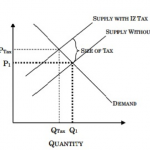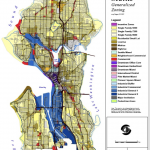Housing Prices: Will Incentives and Inclusion Help? (Part 2)
First of a two part series by Jerrell Whitehead. The posts here on zoning are longer versions of material he completed while at Sightline Institute. His initial interest on this subject came from conversations with A-P Hurd, Vice-President at Touchstone Corporation, who gave a number of reasons why housing construction costs are growing in Seattle. All views expressed here are his own.
Fundamentally, inclusionary or incentive zoning exists in order to make the development of affordable housing a permanent facet of a community’s new development. Although highly controversial, such programs have been legal in US municipalities since 1973. The city of Seattle is not alone in questioning its incentive zoning scheme. In 1999, Oregon banned the zoning program completely, although advocates have tried for years to overturn the ban. Oregon and Texas are the only two states that ban the practice.
Despite operating for a number of years, it is incredible that an issue as divisive as this has hitherto produced mostly theoretical data, with a noticeable absence of empirical studies. Still, although the data sample is small, it is not completely non-existent. In 2008 (updated in 2010) New York University’s Furman Center for Real Estate & Urban Policy waded into this debate with a policy brief that asks three important empirical questions:
- What kinds of jurisdictions adopt inclusionary zoning?
- How much affordable housing has been produced in different inclusionary zoning programs, and what factors influence production levels?
- What effects has inclusionary zoning had on the price and production of market-rate housing?
To answer these questions, three metropolitan areas were selected: the San Francisco area, suburban Boston, and the Washington D.C. region. As too often happens when researching, data constraints (i.e. the small amount of participating jurisdictions in the D.C. area) prevented full statistical analysis.
|
San Francisco Area |
Suburban Boston |
Washington, DC Area |
|
| Prevalence |
7/10 counties |
99/187 cities & towns |
5/23 counties |
| Year Adopted Median |
1973-2004 |
1974-2004 |
1973-1996 |
| % of Mandatory Programs |
93% |
58% |
80% |
| % of Units That Must Be Affordable | |||
| Median |
15% |
10% |
8.13% |
| Range |
5-25% |
5-60% |
6.25-15% |
Key Findings On Inclusionary Zoning Adoption
Jurisdictions are more likely to adopt an inclusionary zoning program when they:
- Are larger and more affluent
- Have neighboring jurisdictions that have ordinances
- Have adopted other land use regulations (specifically cluster zoning or growth management).
Key Findings On Inclusionary Zoning Production
The longer ordinances have been in place, the more affordable units produced:
- In the Washington D.C. area, programs produced 15,252 affordable units, but roughly 3/4th of the units are in Montgomery County, the nation’s oldest inclusionary zoning program
- As of 2004 in suburban Boston, 43% of jurisdictions with inclusionary zoning had zero affordable units. Precise counts were unavailable, primarily because many of the ordinances were newly enacted
- In the San Francisco area the median annual production across all programs was nine affordable units per year. For the region as a whole, inclusionary zoning programs produced 9,154 affordable units (1973-2004).
Key Findings On Inclusionary Zoning’s Impact On Housing Market
- In the San Francisco area, there is no evidence that inclusionary zoning impacts either the prices or production of single-family houses. Researchers found that, when regional housing prices are declining, ordinances are associated with a small decrease in local housing prices, but when regional housing prices are appreciating, inclusionary zoning programs are associated with a small increase in local housing prices. Regardless of whether the market was up or down, inclusionary zoning had no impact on San Francisco area housing prices or overall supply of housing.
- In suburban Boston, during periods of rising housing prices inclusionary zoning modestly constrains housing production and increases housing prices, but had no impact during declining housing markets.
Analyzing the implications of their data, Furman Center researchers concluded that inclusionary zoning isn’t necessarily a panacea for solving housing affordability problems. Indeed, the Bay Area, with over 15,000 affordable units created since the 1970s should stand as a success story, but the area still consistently ranks as one of America’s priciest housing markets. The researchers end with caution, warning that before inclusionary zoning policies are expanded, municipalities must long consider the potential negative impacts on the price and supply of market-rate housing.
The Supporters
Those who agitate for inclusionary zoning are often vocal about its myriad benefits, but most often lofty notions of social equity are praised the loudest. Proponents point to years of exclusionary zoning, racial redlining, and other historical instances of powerless groups thrust far out to the margins of society. In a swift, forceful action, affordable units built onsite effectively integrates communities on key racial and socioeconomic fault lines. Thus, inclusionary zoning serves as a powerful tool that reverses decades of past transgressions by myopic local governments and callous landlords.
Following concerns with social equity, inclusionary zoning supporters will also list access to public services and city amenities for low income groups as another positive bestowed by the ordinances. Furthermore, proponents rationalize why developers need to contribute something the public values in the community where they seek to do business. Here, they state that developers too often try to skirt the idea that they are in fact members of society, and therefore they have a duty to provide affordable housing. On top of that duty, the argument goes, developers have plenty of money and will still be able to turn a profit, so what’s the harm in adding the extra units? In the end, the developers collect their permit to build; the city meets its quota of affordable housing units, and members of the community get to move into new, well-situated lodgings.
For these advocates, their worst nightmare is a city without inclusionary zoning, as they believe a city lacking these ordinances would inevitably be defined by those with capital and power. Whether true or not, a vital question is whether the cost of the policy is one worth bearing.
The Opponents
Detractors of inclusionary zoning bluntly state that such schemes are, by definition, price controls and act as a tax on development. Inclusionary zoning has been deemed by economists as distinct from rent control, but they conclude that any form of price control on a percentage of new housing will have many of the same effects as rent control, namely constrained supply, higher prices, and lower quality housing. Cue the standard economist joke that rent control appears to be the most efficient technique presently known to destroy a city—except for bombing.
Economists will point to the graph below as the visual argument against inclusionary zoning. The demand curve plots the quantity demanded by consumers at different prices, and the supply curve plots the quantity supplied by builders and landowners at different prices. The demand curve slopes downward because as consumers are forced to pay more, they will buy less, and the supply curve slopes upward because as producers receive more, they’ll supply more resources for residential development.
Impact of an inclusionary zoning tax on new market-rate housing Inclusionary Zoning Graph by Benjamin Powell & Edward Stringham
Oftentimes, inclusionary zoning opponents question the economic knowledge of their intellectual adversaries, especially on the question of who actually pays the ordinance fee. Developers must certainly provide the project financing and take the risk of building both market and affordable units, but it is highly unlikely they will pay the entire cost. This burden is shared in some combination by the builders, landowners, and market-rate homebuyers. But recall that in practically every circumstance, taxed goods lead to higher prices for consumers. On the subject of “Who pays?” the economists Powell and Stringham conclude:
If people knew that landowners had to bear the cost of providing affordable housing, the policy might be considered unfair or even a taking because landowners have no more responsibility to pay the full cost of social policies than anyone else. If people knew that market-rate homebuyers had to bear the cost of providing affordable housing, the policy also might be considered counterproductive because rather than creating more affordable housing, the policy would be making the majority of homes more expensive. On the other hand, many people consider it acceptable for builders to bear the cost of inclusionary zoning.
Finally, it was previously written that the supporters of inclusionary zoning often lay claim to the moral high ground in justifying their support for the policy scheme, reasoning that no matter the program’s cost, racially and socially integrating our communities and expanding access to opportunity for all is definitely a worthy cause. Demonstrating the complexity of this debate, opponents to inclusionary zoning also cite social equity as a reason why they do not support the policy.
The underpinning rationale for this position is best encapsulated in Yale Law Professor Robert Ellickson’s useful article, titled, “The Irony of ‘Inclusionary Zoning’,” where he argues that by decreasing housing development, the price on all housing goes up; therefore the ironically named policy is exclusionary. While a tiny slice of society will get access to new housing at a below-market price, the overwhelming majority has to fend for themselves in a market with higher prices and overall lower supply.
Inclusionary Zoning? Or…
Despite the niceness of its name—since anything “inclusionary” trumps that which is exclusionary—the dirty, yet open secret of the policy scheme is this: in every documented instance inclusionary zoning simply creates a paltry sum of affordable units. As shown above, the Bay Area has produced approximately 295 units a year since 1973. In Seattle, 714 affordable units have been created since 2001—a tiny share of new housing in the city, in large part because the weak incentives have discouraged developers from participating. Note that Seattle has added 40,000 new households between 2000 and 2014, an average of 2,850 per year. In sum, if well-meaning stakeholders are interested solely in whether or not affordable units exist, inclusionary zoning is indeed a means of producing them. However, although inefficient as a means of generating affordable housing stock, it is certainly efficient at drawing the ire of developers and those faced with higher housing prices.
Additionally, this survey of inclusionary zoning has not dealt with other key details that surround the policy. The questions are legion: What is the cost of administering the program? Who determines those who live in the units? What happens when a low income family begins to earn more money—are they promptly evicted? Also, one must not forget the philosophical issues at play: Does society agree housing is a right? If we do agree housing is an absolute right, do we also agree that, no matter the cost, it is a right for all to live in the most wealthy and opportune of settings?
And lastly, we must investigate further the notion that racial and economic integration of the housing market is a net positive, starting with questioning the people who themselves have been integrated into higher priced units. Recently, the New York Times completed such a study, discovering a unique tension between poor and rich in Manhattan’s luxurious high-rises. I wonder if such evident discord between classes dampens the enthusiasm of the inclusionary zoning advocate, since along with its attendant economic issues, even the utopian-like idea of stress-free socio-economic integration is problematic.
Exclusionary Zoning?
Inclusionary zoning in part exists to fix the housing problems created by exclusionary zoning. But while debates over the usefulness of inclusionary zoning spark white-hot passions, they typically miss a more fundamental problem: Cities of the Pacific Northwest still struggle mightily with the legacy of exclusionary housing policies.
Distressingly, exclusionary zoning remains the norm in Seattle, and creates huge problems for housing costs. Zoning policies continue to reserve the majority of residential land for single-family housing, which limits the supply (and increases the price) of land for multifamily development. More specifically, Seattle is zoned 65% single family housing, as shown by the light yellow in the map below (with a lot size between 5,000 and 9,600 square feet).
Cities continue to outlaw many of the most inexpensive forms of housing, as well as once-common forms of compact, family friendly housing such as courtyard apartments. New forms of lower-cost housing—small (or micro) apartments, housing without parking—face fierce opposition and political roadblocks.
Curbing exclusionary zoning offers one place where all sides of the inclusionary zoning debate can agree. In the cities of the Pacific Northwest, policies that help to make new lower-cost housing both legal and profitable—and that work to gradually erase the region’s legacy of exclusionary zoning—ought to be a large part of any debate over housing affordability.
Jerrell Whitehead is a former Research Fellow of the Sightline Institute. He is a Bill & Melinda Gates Scholar, and earned his Master’s (MPhil) and PhD in economic and social history from the University of Cambridge. Thanks for research assistance must be extended to A-P Hurd of Touchstone Corporation, Kayla Schott-Bresler of the Housing Development Consortium, and Esther Handy, legislative aide to Seattle City Councilmember Mike O’Brien.




